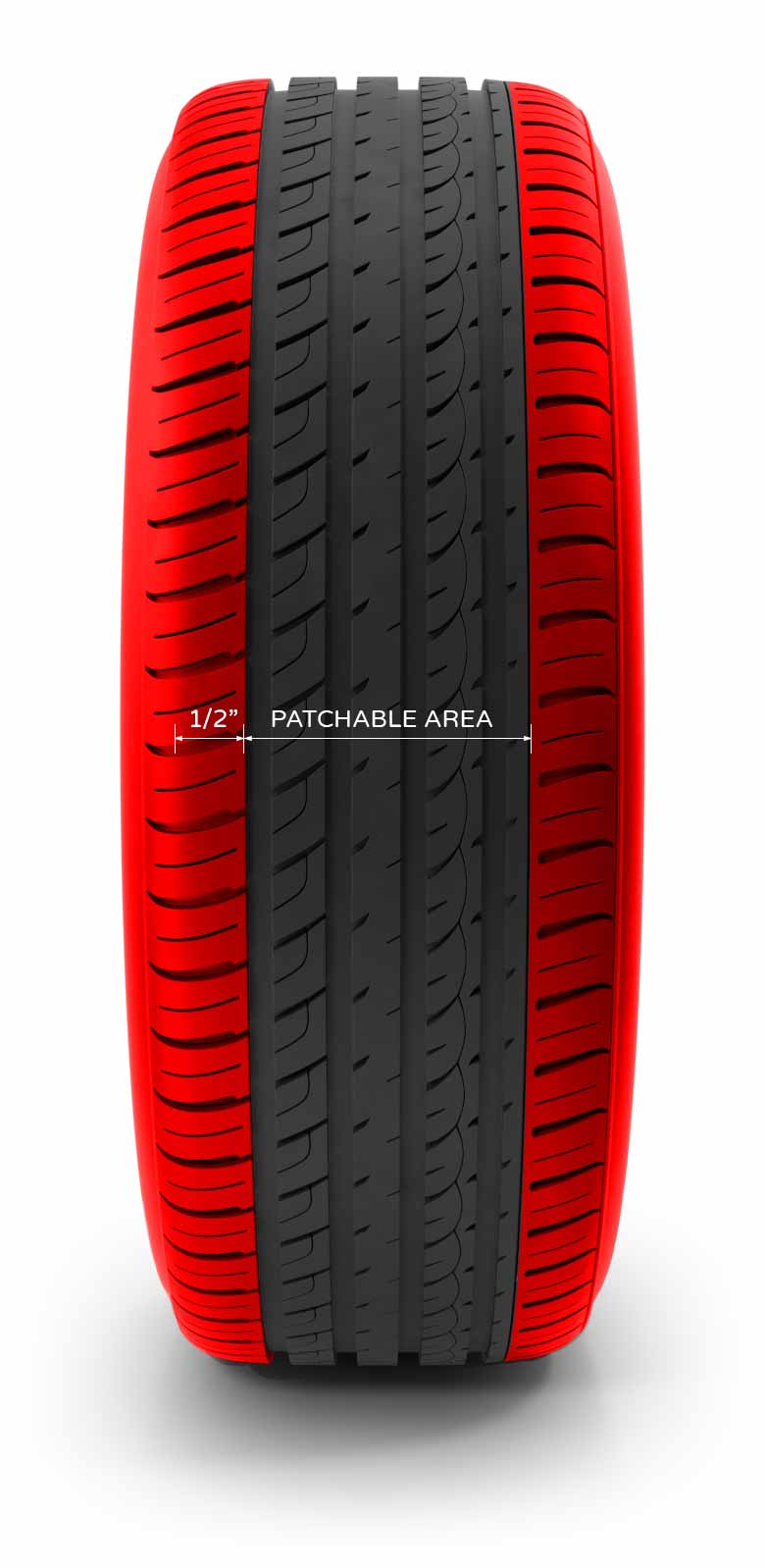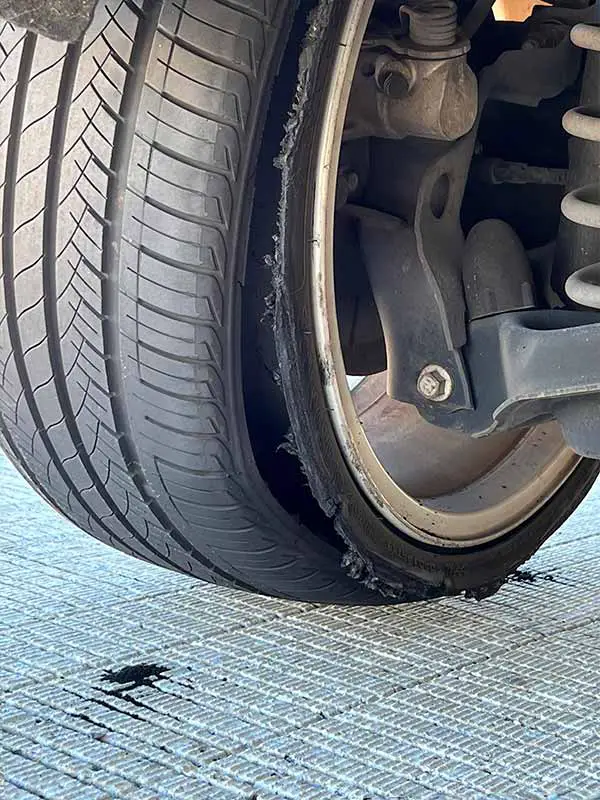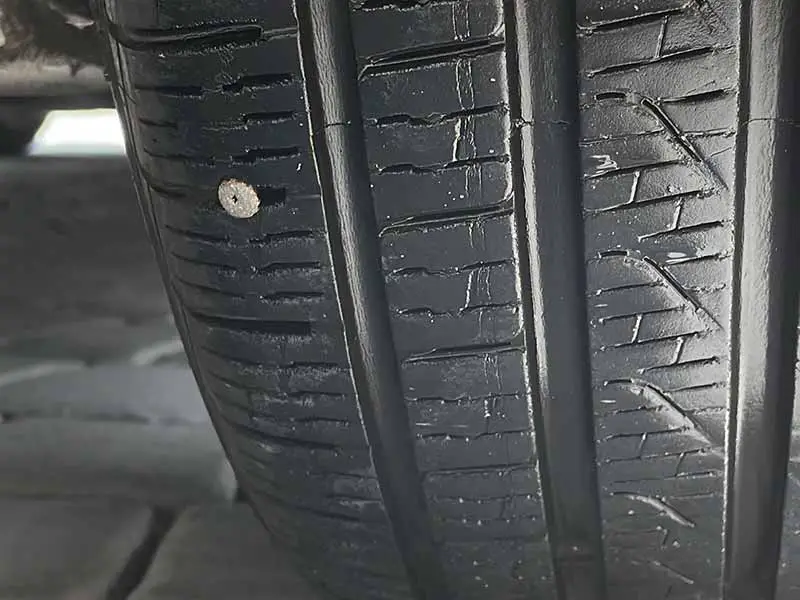You may be aware or have recently had it explained that a puncture too close to the sidewall could not be patched. A screw or nail too close to the sidewall may not hold or even lead to tire failure over time.
But how close to the sidewall is too close?

How Close To Sidewall Can A Tire Be Patched?
A tire can be patched as close as 1/2″ to the sidewall from the point the tread pattern and internal steel belts begin.
You can not use a plug or patch kit to repair a puncture greater than 1/4″ in diameter.
It can seem arbitrary that a puncture that occurs a quarter inch closer to the tire’s centerline can be patched while the puncture you have can’t. Unfortunately, this is true.
Let’s take a closer look.
Why Can’t You Patch A Tire Shoulder Or Sidewall?
There are a few reasons why it’s not recommended to attempt to fix sidewall damage or a punctured tire tread near the sidewall:
Tire Flex And Movement
Plugging or patching a tire sidewall or tread near the sidewall will be much more likely to fail over a short time. The car’s weight puts the most stress on tire sidewalls.

Plugs can work their way out or move in such a way that the tire can’t properly hold air pressure. As you drive, the portion of the tire that flexes and moves the most is the sidewall and tire shoulder. This movement can stretch patches and cause them to leak and tear open.
These failures of a plugged or patched tire can be slow and more of a nuisance, or they can be rapid and lead to a blowout or accident.
Structural Damage
Another reason to avoid patching or plugging a tire in the shoulder or sidewall is the damaged tire sidewall may have lost structural integrity and could begin to break down more quickly over time, leading to a blowout or flat tire.

Inside the sidewall are no steel belts that give the sidewall as much structure as the rubber beneath the tread pattern. Air pressure is what gives sidewalls their strength, unlike the tread.
Liability
Nothing stops you from attempting to plug or patch your tire’s sidewall puncture. But professionals at your local tire shops can get sued if they perform a potentially unsafe service.
It doesn’t matter whether you tell them you give permission or not. Repairing sidewall damage or a punctured tire in the shoulder isn’t something they should do under any circumstance.
You’ll need to do the job yourself if you’re hellbent on salvaging the tire and not spending the money to replace it. To be clear, this is NOT RECOMMENDED. Tire sidewall damage can easily lead to a flat tire or, in extreme circumstances, an accident and death.
Tires are arguably the most critical component of your car or truck; not taking this fact seriously is unwise.

What Happens If You Plug Or Patch A Tire Too Close To The Sidewall?
A plugged or patched tire is weaker at the location of the puncture. This isn’t much of a problem near the tread centerline. But as you move close to the tire’s sidewall, the stresses of the tire flexing and stretching under the weight of your vehicle make it much more difficult for these repairs to hold up over time.
Hard cornering puts a lot of strain on your tires. But what many people might not realize is how much and how often your tires flex. Even driving in a straight line causes the tire sidewalls to flex repeatedly many times a second when driving at speed.
As the tire rotates, the portion of the tire in contact with the road will cause the sidewall to buckle slightly due to your car or truck’s weight. This creates a lot of heat. While your tire is designed to handle these stresses, a weak point in this critical area can expand over time.
For safety reasons, the only long-term solution for a puncture in or near the sidewall of your tire is to replace the entire tire.
Is It Legal To Patch A Tire On The Sidewall?
While there don’t seem to be any laws specifically prohibiting patching the sidewall or shoulder of a tire, there could still be legal ramifications. This is why tire professionals refuse to patch or plug a tire with a puncture in the sidewall or shoulder.
It is common for customers to think that their local tire shop is just trying to upsell them to a new tire due to a simple puncture. But this couldn’t be further from the truth.
Professionals providing services to the public could be held responsible for the outcome of a tire repair failure if it is found that the repair was not recommended to be performed.
Tire Plug Vs Patch
The two longer-lasting ways to repair a tire puncture are plugs and patches. Understanding the differences between plugs and patches is important since they each have pros and cons.
Neither of these solutions should be used to repair sidewall or tire shoulder damage. A new tire is always the correct choice if your tire has a sidewall or shoulder puncture.

Tire Plug Kit
Tire Plugs
Tire plugs are rubber strips inserted into a tire from the outside and seal a puncture with or without a liquid sealant.
Using a tire plug requires the puncture to be reamed out to smooth the opening. This will make the plug seal better against the tire rubber. The plug strip is inserted with a unique tool, and the remaining plug material is trimmed away.

Some plug kits will include a liquid sealant or cement to help secure the plug material and seal it better, but this is not always the case.
Tire plugs are not designed to be permanent fixes, but they will usually last for many years if used in the appropriate location and properly used.

Tire Patches
Tire patches are a permanent tire repair when used on punctures in a repairable area. They are recommended to be used on punctures that have been previously plugged or sealed with a temporary sealant.
Tire patches require removing the tire from the wheel and applying the patch with a vulcanizing cement to the tire’s interior at the puncture site.
An appropriately patched tire can seal larger punctures than plugs and last for the remaining life of the tire.
Resources
Below are some links you may find helpful when learning about tires
Final Thoughts
Finding out that you can’t patch your tire due to a nail puncturing it too close to the sidewall can be frustrating. Tires aren’t cheap, after all.
But it’s important to understand that patches on the shoulder or sidewall won’t hold up over time and will eventually fail. Your tire professional isn’t just trying to make a few extra bucks. They are covering their rear and ensuring that you’ll be safe.
Good luck and happy motoring.





